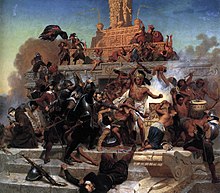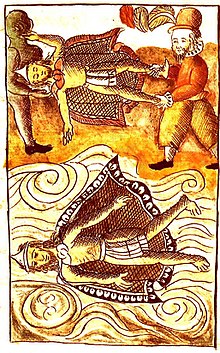Still sad
As Noche Triste (Spanish for Sad Night ) the events of the night of June 30, 1520 are referred to in the Spanish occupiers from the Aztec capital Tenochtitlan fled.
A detailed account of the events before and after the Noche Triste can be found in the article Spanish Conquest of Mexico .
prehistory
Since 1517, two expeditions by the Spanish had already reached the Atlantic coast of Central America and heard of a powerful kingdom in the interior. In 1519, Diego Velázquez de Cuéllar , the Spanish governor of Cuba , commissioned Hernán Cortés to equip a fleet that had been commissioned to establish trade relations with the inhabitants of this empire. Shortly before the fleet left, Velázquez tried to release Cortés from his post for personal reasons, but the latter found out about the plan in good time and sailed away with his men.
On Good Friday 1519, Cortés landed with his small army near the present-day city of Veracruz on the coast of mainland Mexico. There he was told about the rich and powerful city inland - Tenochtitlán . Cortés decided to follow up on reports of Tenochtitlán's wealth and set off there with his men. On the way, the Spanish troop fought a few skirmishes with locals, from which the Spaniards emerged with practically no losses. This quickly gave rise to rumors of the invincibility of the Spaniards among the peoples of central Mexico. In the meantime, however, they had already learned so much about the numerical superiority of the Aztecs that they allied themselves with their mortal enemies, the Tlaxcalc .
On November 8, 1519, Cortés and his men arrived in Tenochtitlán . They were welcomed there by the Aztec ruler Moctezuma II and received as guests. However, the Spaniards were concerned that they could be attacked by the Aztecs in the unknown city at any time. So Cortés decided a week after their arrival to capture Moctezuma and thus take power in Tenochtitlán. The Aztecs remained calm for the time being, but resistance gradually developed in the months that followed.
In the spring of 1520, Diego Velázquez de Cuéllar finally sent a troop of soldiers with 19 ships from Cuba to the mainland. He had given the command of this company to Pánfilo de Narváez . When it landed on the coast in March 1520, Cortés had to react. He sent spies disguised as messengers to Narváez to investigate his strength. All the negotiators and messengers who Narváez sent to Cortés, however, he bribed and ordered them to recruit among Narváez men for his own cause. You should desert and join him yourself. While Narváez was still on the coast and harassed the peaceful locals in Cempoala , Cortés was already advancing against him from Tenochtitlán. He left Pedro de Alvarado with a small crew to guard the city as well as King Moctezuma and the treasures that had meanwhile been gathered.
La Noche Triste
The Templo Mayor massacre
While Cortés was preparing to fight with Narváez's troops, the Aztecs in Tenochtitlán were preparing their traditional spring festival. The Spaniards who stayed behind in the city were nervous because they faced a large hostile population with only a few men. In a panic reaction, Pedro de Alvarado had the participants of the festival at the Templo Mayor ambushed and killed on May 23 . This sparked a riot.
For many days the Spaniards were besieged and attacked. Again and again soldiers were killed in these fights and almost all men were wounded. They were only able to withstand the violent attacks of the angry Aztecs with difficulty, because food was also becoming scarce. The Aztec warriors tried everything to break into the palace where the Spaniards had holed up. They set fire to the heavy entrance gates and tried to burn them down.
Cortés' return

Shortly before the breakthrough of the Aztecs, Cortés returned on June 24th. When he arrived in Tenochtitlán the situation was calm and the attacks had stopped. Cortés reacted very indignantly to the statements of Pedro de Alvarado, because he himself had previously approved the implementation of the Spring Festival. Alvarado defended his actions, but could not plausibly explain the attack on the celebrating Aztecs. When Cortés heard of renewed unrest, he sent Diego de Ordás with a few hundred men to the city. He should see what was going on there. But shortly after leaving the palace grounds, Ordás was violently attacked by the Aztecs. He lost a total of 23 men; many more were wounded, including himself, whereupon he and his men returned to the palace. The Aztecs now attacked with vehemence. Although many of them were killed, they did not let up. Again they set fire to the gates of the palace. Lacking water, the Spanish found it difficult to put out the fire. They were starving and constantly had to fend off new attacks by the Aztecs.
The death of Moctezuma II.
Finally, the Spaniards brought their captive King Moctezuma II before the Aztecs to calm the Aztec people. But when he was standing on a roof terrace and speaking to his people, the inhabitants of the city began to throw stones at him. Although the Spaniards tried to cover Moctezuma with their shields, he was hit several times in the head. The soldiers took him back to the palace , where he succumbed to his injuries. His body was later turned over to the Aztecs.
When the warriors saw their dead king, they believed the Spaniards had killed him. Cortés tried to talk to them again, but this time unsuccessfully. Now he saw no other way out than to leave the city. But the Aztecs had broken the dams that connected the mainland to the island. They really wanted to prevent their opponents from escaping the city. Cortés then had all the beams torn out of the palace and built portable bridges from them.
Escape
On the night of June 30th to July 1st, 1520, the Spaniards and their allies secretly left the palace. The share of gold for King Charles V alone had to be carried by eight wounded horses and eighty Tlaxcalteks . Each man took as much of the remaining gold as he could carry. In addition, the Tlaxcalteks also carried the portable bridges. Then they moved out as quietly as possible.
In fact, they reached one of the dams unseen. But then they were discovered and the alarm was raised. Within minutes, the Aztecs attacked from the water with hundreds of canoes ; The rearguard was also violently attacked on the dam. The refugees had to fight their way through the city in the dark on streets that were softened by the rain and increasingly covered with corpses.
Meanwhile, the first breach in the dam was overcome with the help of the portable bridges. As a precaution, the Aztecs had interrupted the dam in several places. So the Spaniards finally had to cross the water when they no longer had another portable bridge. In these places in particular, the Aztecs attacked with great severity from their canoes. Some men had too heavy a load of gold and drowned because they were dragged down by the weight of the gold and their heavy armor. When, after many hours of fighting, almost all of the survivors had crossed the breach in the dam, the rest of Pedro de Alvarado's company, which had defended the end of the train, was the last group to face the Aztecs. As the last Spanish soldier, Alvarado took a run-up and swung himself, like a pole vaulter today, with the help of his lance over the gap in the dam and thus reached the other side. This jump went down in history as the Salto de Alvarado ("Leap of the Alvarado"). Of his company , only seven Spaniards and eight Tlaxcalteks survived.
Effects
Towards morning the troops reached a temple pyramid two leagues from Tenochtitlán. Cortés noted how many of the refugees had survived the outbreak. Of the more than 1,300 Spanish soldiers, only 425 were able to escape to the lake shore. The vast majority of women - who had stayed within the vanguard and had been specially protected - survived unharmed (all Indian women, including Malinche . Many were baptized and married to Spaniards).
Most of the men, like the twenty-three horses that survived, were wounded. About 70 horses had been killed. Almost all of the 2000 Tlaxcaltec warriors were also killed. The only Spaniard who had survived the Noche Triste was María de Estrada ; she fought alongside her husband in the middle section of the army. Most of the gold that was taken with them had sunk in Lake Texcoco or had fallen into the hands of Mexico.
Those who had escaped could see in the distance the smoke of the sacrificial fires on the pyramids in Tenochtitlán. At this point, the soldiers who had been captured were being sacrificed to their gods by the Aztecs. After a short recovery period, the Spaniards moved on to Tlaxcala. In this way the Spaniards were attacked again and again. These attacks culminated in a battle near Otumba . Despite being numerically inferior, the Spaniards achieved a great victory here, thanks to the skillful use of the remaining cavalry - 20,000 Aztecs are said to have fallen.
Among the soldiers who died in Tenochtitlán was a Spaniard who had come to Mexico with Pánfilo de Narváez and was infected with smallpox . The disease spread rapidly in the city and killed a large part of the population, including Cuitláuac , the successor to Moctezuma II. The new king Cuauhtémoc was now faced with the task of defeating the Spaniards. However, with reinforcements from Spain and other allied locals, Cortés succeeded in the spring of 1521 with the siege of Tenochtitlán. On August 13, 1521, the last Aztec resistance in the city finally went out.
literature
- Bartolomé Benassar: Cortez the Conquistador. The conquest of the Aztec Empire. Artemis and Winkler, Düsseldorf a. a. 2002, ISBN 3-538-07133-0
- Bernal Díaz del Castillo : History of the Conquest of Mexico. Edited and edited by Georg A. Narciß. Insel-Verlag, Frankfurt am Main 1988, ISBN 3-458-32767-3 ( Insel-Taschenbuch 1067), (Spanish original title: Historia verdadera de la conquista de la Nueva España ).
- Hernán Cortés : The Conquest of Mexico. Three reports from Hernán Cortés to Emperor Charles V. Edited by Claus Litterscheid. 5th edition. Insel-Verlag, Frankfurt am Main 2005, ISBN 3-458-32093-8 ( Insel-Taschenbuch 393).
- Hugh Thomas : The Conquest of Mexico. Cortés and Montezuma. S. Fischer, Frankfurt am Main 1998.
Web links
- http://www.mariner.org/exploration/index.php?type=explorer&id=34
- http://www.motecuhzoma.de/alvarado.html
Individual evidence
- ↑ cf. Díaz del Castillo / Narziss 1988, p. 294

